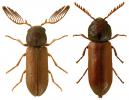Ptinidae
Common name:
Wood-borer beetlesNumber of species:
57Size Range:
1-7mmTarsi:
5-5-5.Images:
Description:
There are 56 British species in this family, which also contains the former family Anobiidae. Most species are small (1-7mm) woodboring beetles, though others are found in stored produce. There are eight subfamilies in Britain.
Eucradinae is represented by a single species, Hedobia imperialis L., the larvae of which bore Rosacea shrub species. Adults are 4-6mm long and pubescent, with a grey X across the elytra, and can be found by beating old hedges of hawthorn.
The spider beetles are subfamily Ptininae, and there are 22 British species. Mostly with globular abdomens and yellow-pubescent appendages, the resemblance to a spider can be striking. Generally found amongst stored products or old timber, often in buildings.
Subfamily Dryophilinae contains just three British species, two of Dryophilus and one Grynobius. Grynobius planus (Fabricius) is widespread but local in dead hedges and decaying timber, 4-6mm long with black to dark-red elytra. Dryophilus pusillus (Gyllenhal) is locally common in association with conifers, and D. anobioides Chevrolat is a Breckland species, where it is found in broom Cytisus scoparius (L.).
There are eight species of Ernobiinae in Britain, including the deathwatch beetle Xestobium villosum (De Geer). The six Ernobius spp. develop in conifers, particularly pines, while X. villosum is found in broadleaf timber and Ochina ptinoides (Marsham) can be found in ivy.
Anobiinae includes nine British 2-6mm species, most famously Anobium punctatum (De Geer), the archetypal woodworm. Adults have a humped pronotum and all develop in dead wood, with the exception of Stegobium paniceum (L.), the biscuit beetle, which is a pest of stored products.
Ptilininae includes a single British species, Ptilinus pecticornis (L.). This species is readily recognised from the antennae, which in the female are broadly serrate and in the male, strongly pectinate. A woodboring species, large swarms can occur around the host tree in late spring and early summer.
Xyletininae has two British representatives, the more abundant of which is Lasioderma serricorne (Fabricius), the cigarette beetle. Local but widely distributed, it is a 3mm, shining red, finely-punctate pest of dried vegetable products, including tobacco. The scarce Xyletinus longitarsus Jansson is larger (3-4mm) and found in wood across southern England.
Dorcatominae has 10 rare species in Britain. 2-3mm long, all are short, round beetles with charactistic lobed antennal segments expanded on the inner edge. The group includes fungivores (Caenocara spp.) and woodborers.













